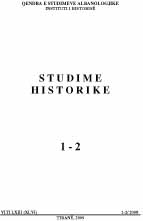Shasi (Suacium, Svacium, Suvacium, Soacium, Svaç) në shekullin XIV-XV
Shasi (Suacium, Svacium, Suvacium, Soacium, Svaç) during the 14th and 15th centuries
Author(s): Luan MallteziSubject(s): History
Published by: Qendra e Studimeve Albanologjike
Keywords: Shasi; Suacium ; Svacium; Suvacium; Soacium; Svaç; 14th ; 15th centuries; Albania; Albanian History;
Summary/Abstract: Shasi is first mentioned in year 1067. During the middle ages it was under the Byzantines and later on under the Serbs invasion. Shasi based its economical and social development in its own “uses” and traditions. Important roles in social-economical and political life of Shasi have played the bishops. During the second half of the 14th century Shasi passed under the control of Balshaj. With the beginning of the ottoman attacks for the invasion of the Albanian lands Shasi started to decline economically. It declined even more due to the war that broke between Ballsha III and the Signoria during 1403-1421. The bishop of Shasi took a clear position in support of Signoria. In 1443 he turned in the favour of Signoria the powerful tribe of Poprati as well as many inhabitants of other villages. As an act of vengeance the adversary burned down the monastery of the bishop and seized the incomes. After 1463 Signoria was involved in the war with the ottoman Turks but Shasi was not an important community any more and many of its inhabitants had abandoned the city. The Earl of Shkodra had conceded it as a pronjie in favour of two citizens in May 1444. Later on Shasi was occupied by the ottoman Turks. Nowadays Shasi is an abandoned and deserted city of church ruins and walls.
Journal: Studime Historike
- Issue Year: 2008
- Issue No: 01-02
- Page Range: 007-020
- Page Count: 14
- Language: Albanian
- Content File-PDF

